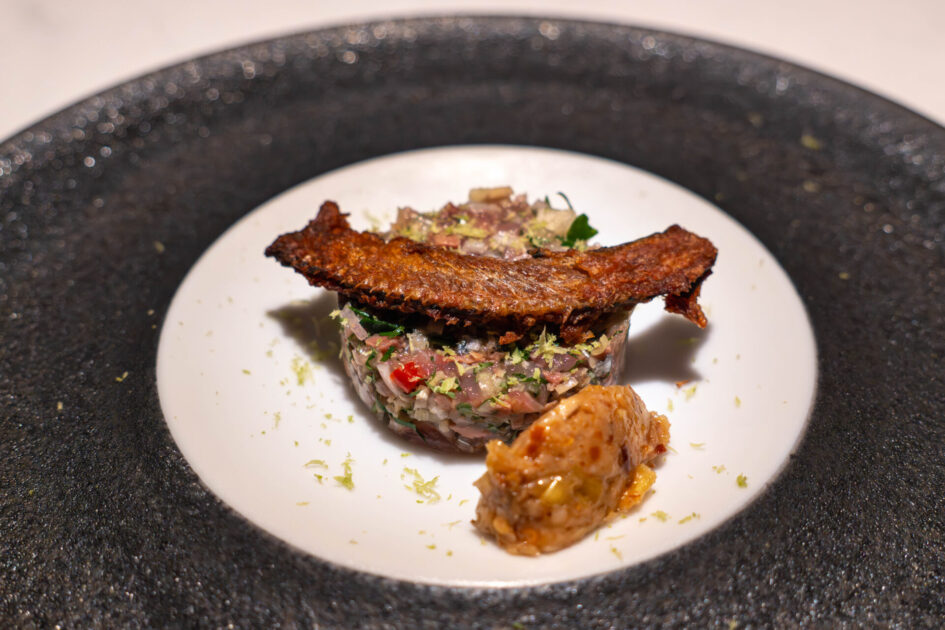※This article contains affiliate links. If you purchase a product through these links, we may receive a commission.
CONTENTS
About Spice & Dining KALA (Spice & Dining Kāla)
Concept
Spice & Dining KALA was originally a restaurant in Nakama City, Fukuoka, focusing on South Indian meals (meals/“mealsu”). It has since relocated to Kokura and now operates in a counter-only style.
Under the banner of an unexplored genre called “Modern Indian,” it freely incorporates elements of Japanese, French, and Thai cuisine, while maintaining a commitment to sugar-free, low-carb, and additive-free courses. In a completely reservation-only setting for a single party at a time, it delivers a special experience that fuses cuisine with music.
Furthermore, the chef has already announced that the restaurant will close in 2027, giving the place an added sense of urgency as a stage for continuous challenges within a limited timeframe.
About the Chef
In Fukuoka’s spice community, he is affectionately known as the “BOSS.” His expertise spans not only South Indian cuisine but also Thai and other Southeast Asian, Chinese, French, and Italian cuisines. He is also deeply knowledgeable about the world of wine.
With such a broad background, he captivates guests not only through his use of spices but also with his skill in combining ingredients, structuring courses, and crafting a narrative within each dish. His approach—conducting dishes like music, calculating the placement of flavors and even moments of silence—transcends genre to design the experience itself. As a truly unique figure, he has had a profound impact on Fukuoka’s food culture.
Restaurant Recognition
Spice & Dining KALA has continued to leave a powerful impression on Japan’s spice scene since its days in Nakama City. In 2016, it received the JAPANESE CURRY AWARDS, recognized for its contribution to spreading the culture of “meals.” It has also been acclaimed for its unique worldview and philosophical approach to cuisine, and has been certified in the Tabelog Awards as a Bronze-level restaurant.
Even after relocating to Kokura, its influence remains strong. In 2024, it was selected for the “Tabelog Asia & Ethnic WEST Top 100 Restaurants,” securing its status as a leading establishment in its genre. Food media have also named it “Japan’s representative modern Indian,” attracting fans from far and wide.

Dining Prelude
Exterior & Entrance
Along the Akizuki Kaidō in Kokura, the KN Building with its vivid orange exterior walls stands out. On the corner, a small plate simply bearing the name “Spice & Dining KALA” serves as the only sign.
Heading down under the stairs, you come upon a plain gray door. The once-posted sign declaring, “For the unaccustomed, this will taste bad,” is gone. Now the door is always locked, and only those with reservations receive that day’s passcode from the chef. Entering the code is the only way to open the door and step into the counter-only space.
From the moment you approach, the performance has already begun—there is a tension and excitement, as if crossing the threshold into a special experience.
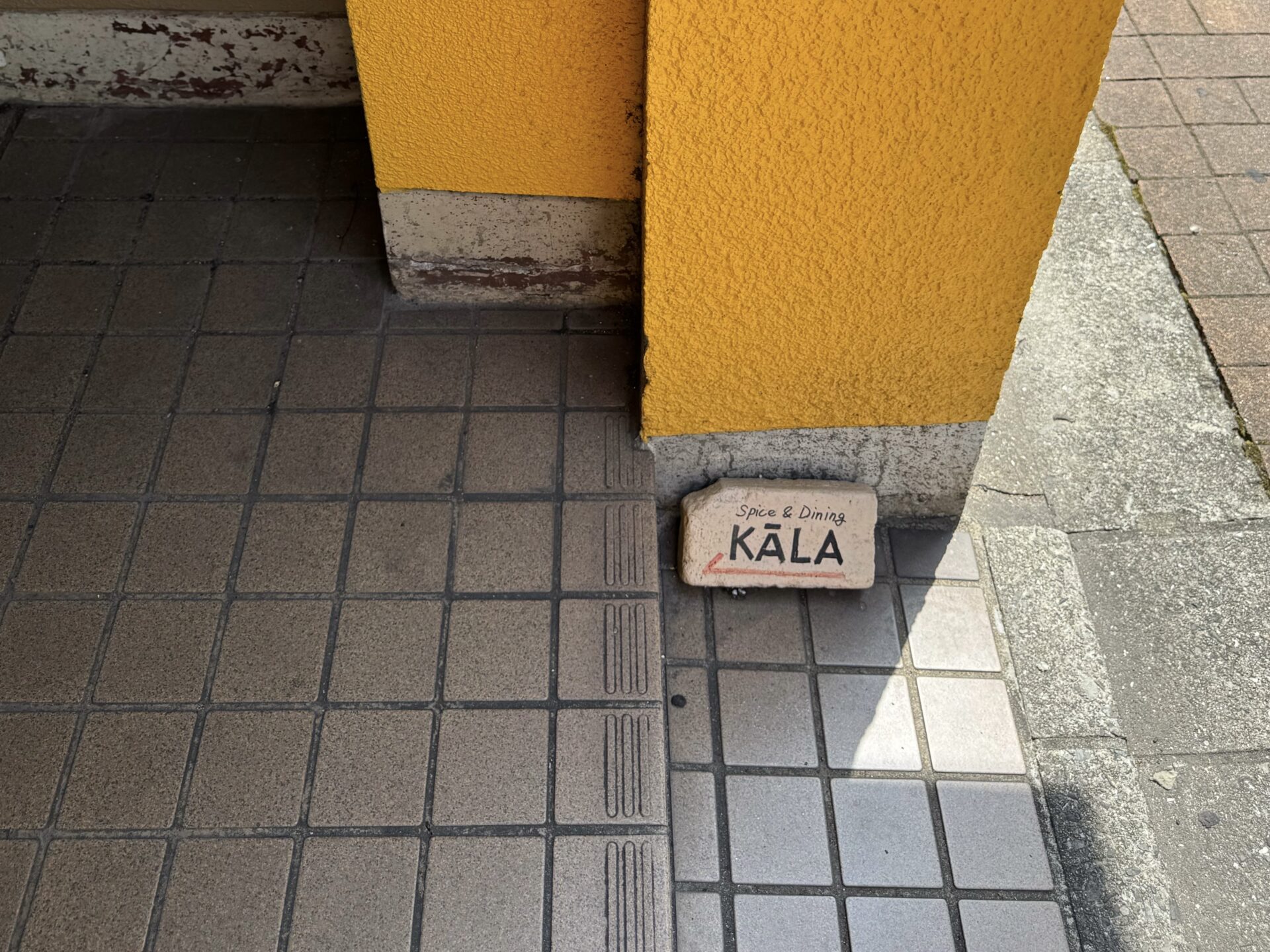
Dining Space
Opening the door reveals an intimate, counter-only space.
A long white counter with blue lights embedded beneath it creates a subtle sense of the extraordinary. On the walls, a cow skull object lends an exotic atmosphere befitting a restaurant of spice cuisine.
The chairs are spaced generously, allowing guests to sit face-to-face with the chef. Behind them, rows of wine and liqueurs line the shelves, suggesting the diverse pairings to come with the spice-centered cuisine.
It is a sophisticated, urban space entirely unexpected from the modest exterior. Though located in a corner of Kokura, stepping inside feels like entering another world altogether.
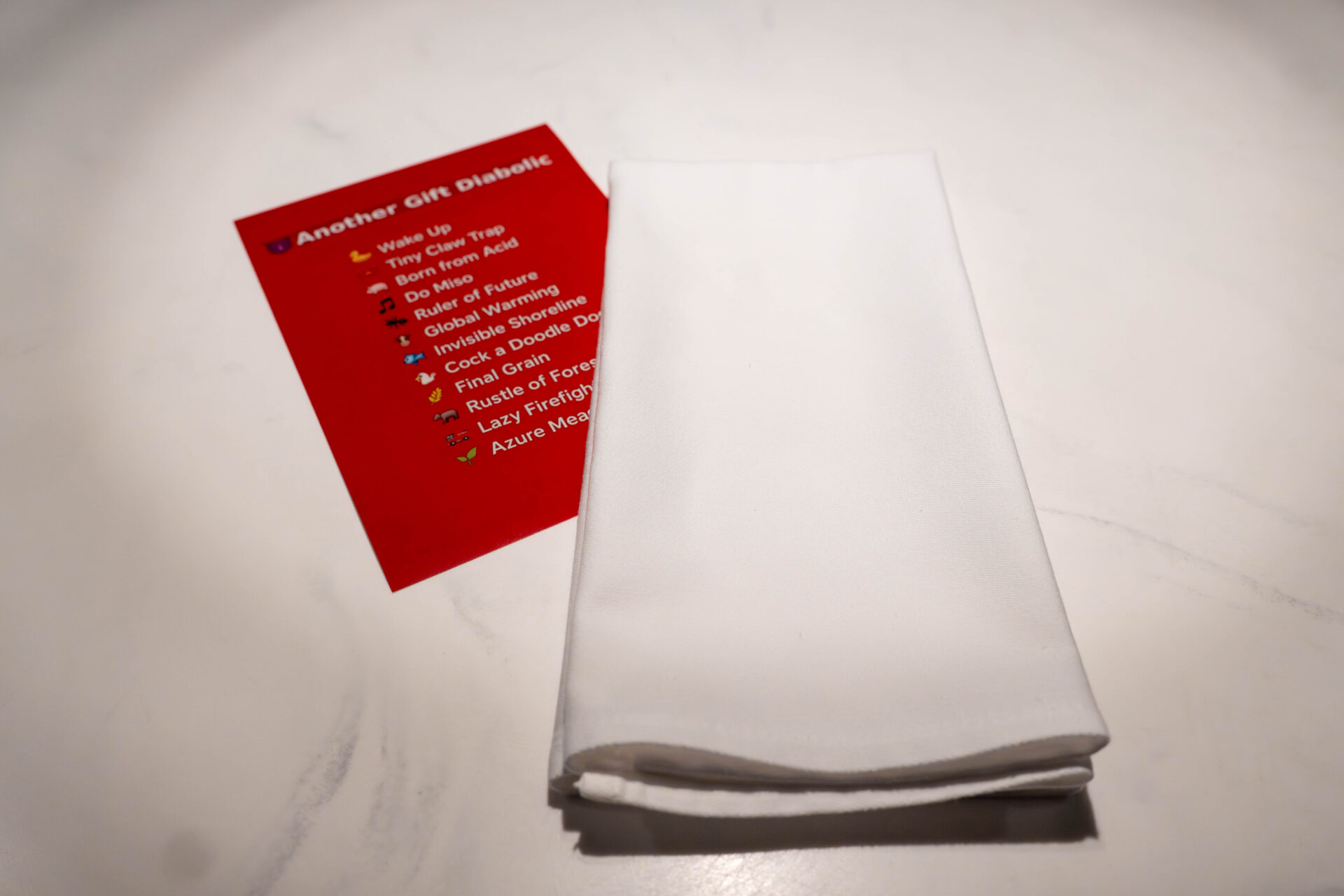
Menu Presentation
On the table is a vivid red card. Instead of dish names, it lists phrases that resemble song titles.
“Wake Up,” “Born from Acid,” “Invisible Shoreline”…
They don’t directly reveal what’s on each plate. Instead, they are composed of abstract words and icons designed to stir the imagination.
This is not just a menu—it’s like the tracklist of an album. The chef, as “conductor,” guides guests through a narrative flow. With each dish, the experience of connecting it to its “track” becomes part of the performance itself.
The concept of fusing food and music is distilled into this menu presentation.

Dishes Experienced
WAKE UP
The course opened with a dish inspired by breakfast in the Isan region of Northeast Thailand.
Jasmine rice was crushed and soaked in broth, finished like a risotto with a silky texture, accented by ginger that awakens the body.
At the center was a quail century egg, served boldly to be eaten shell and all, releasing a unique savoriness and aroma. Around it, fried sen mee noodles were arranged like a bird’s nest, evoking the imagery of morning.
“Wake Up”—true to its name, this starter gave a rush of excitement, as if waking both the body and appetite from the very first bite.
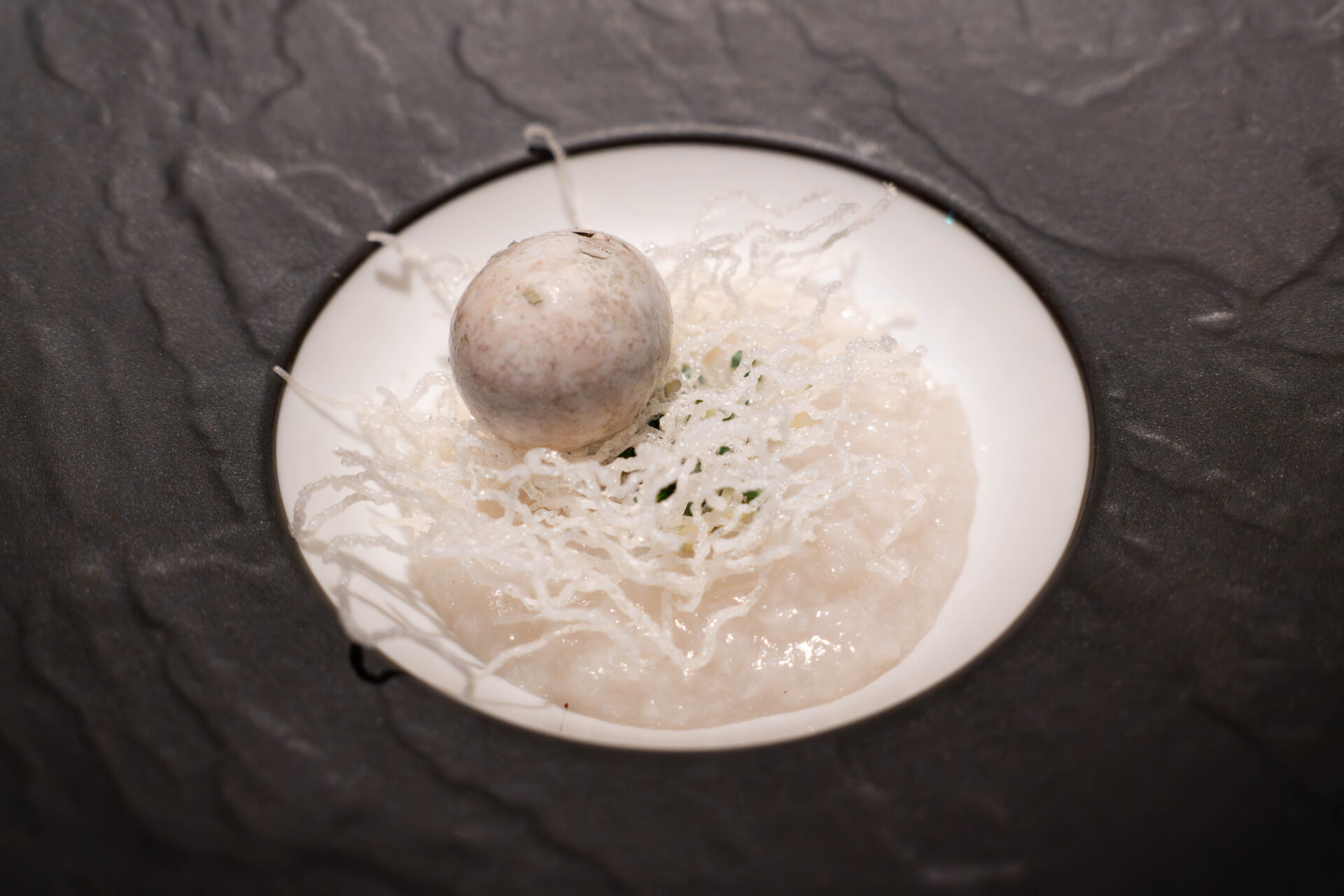
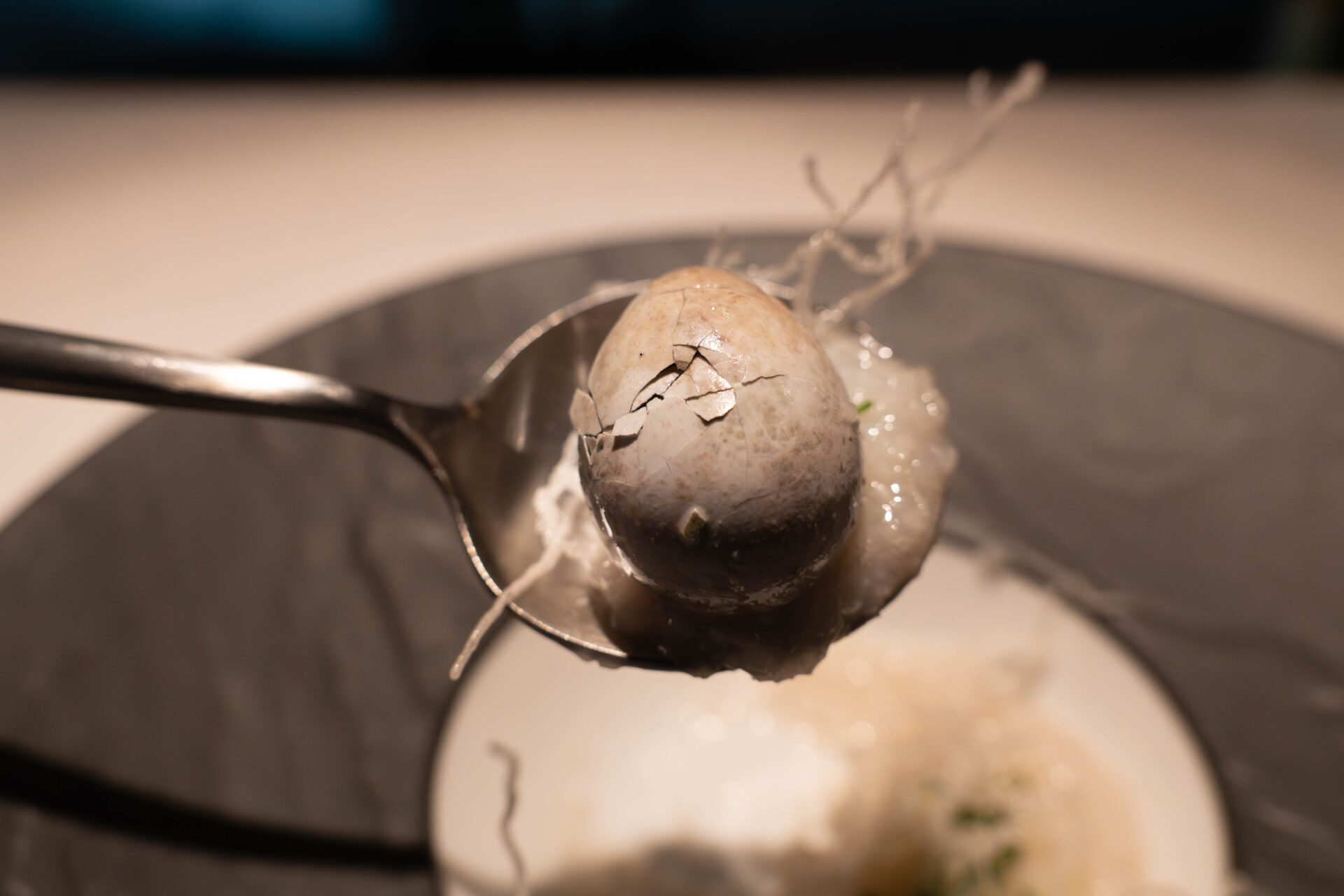
Tiny Claw Trap
The second dish was Som Tam made with fried river crabs.
Crispy fried crabs adorned the top, while underneath, salted raw crabs were hidden.
Beneath thinly shaved cucumbers lay papaya and other vegetables, delivering the crunchy texture typical of som tam, enhanced by spicy heat. The distinct aroma of crab rose up with each bite, leaving a sharp, lingering impression.
“Tiny Claw Trap”—like a small snare with claws, this dish combined lightness with an edge.
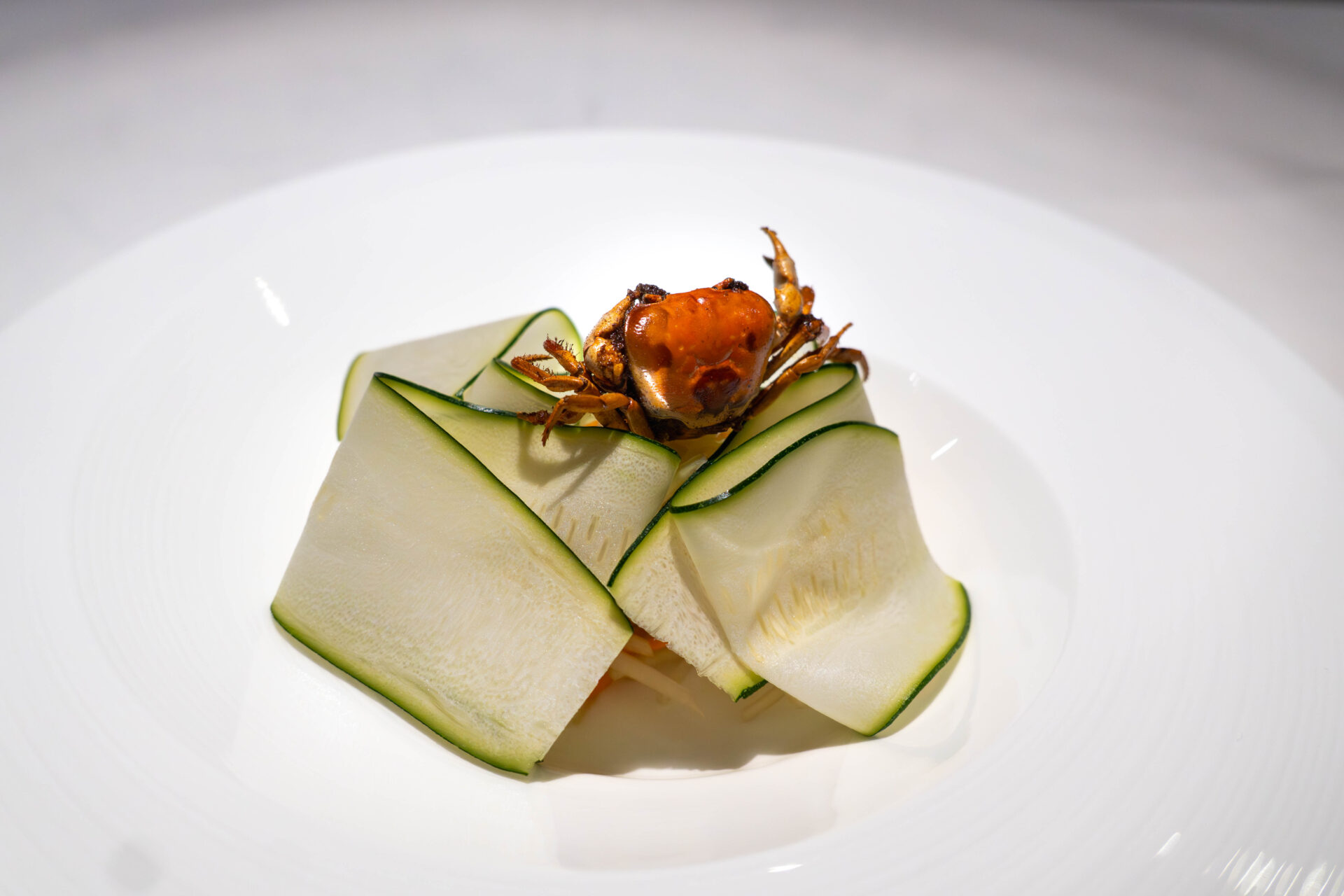
Born from Acid
The third dish was “Pâté de Naem.”
While rooted in the French pâté de campagne, it centered around raw sausage (naem) from Kumamoto’s “Running Pork,” fashioned into a terrine.
It was accompanied by a vivid green sauce made primarily of cilantro, with lemongrass, kaffir lime, and green chili. The layered acidity and heat embodied the title “Born from Acid.”
This style—classic French technique interwoven with the acidity and fragrance of Southeast Asia—was a perfect symbol of modern cuisine.
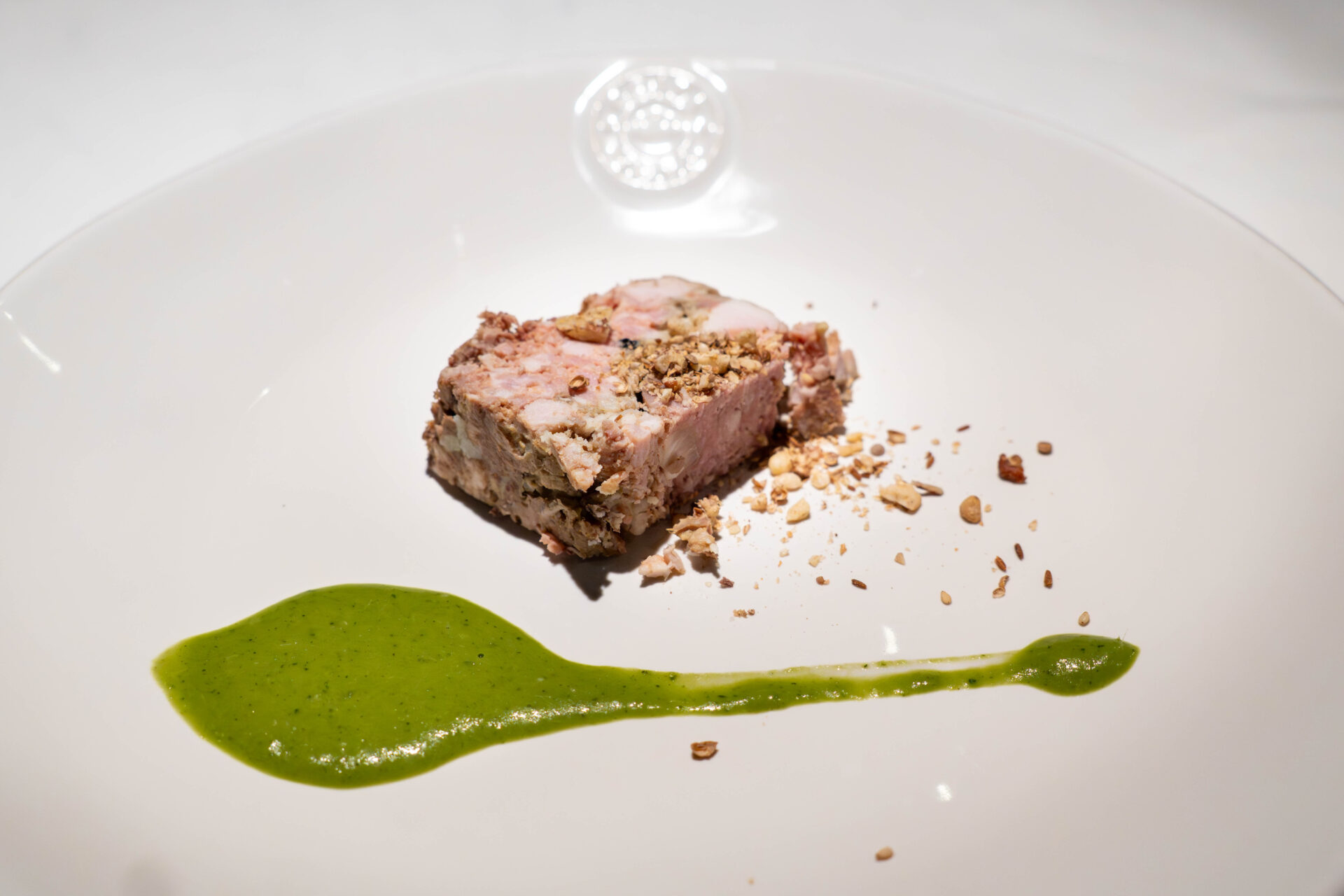
Ruler of Future
Here appeared “Ruler of Future.”
Ants, eaten in Thailand’s Isan region, were transformed into a Japanese-style chawanmushi (steamed egg custard).
The base drew inspiration from pu pad pong curry. The umami of crab was joined by Isan weaving ants and their eggs, adding acidity, aroma, and the popping texture of the eggs. Smooth chawanmushi combined with spice heat and the distinctive flavor of ants, evoking unfamiliar sensations with every bite.
The title “Ruler of Future” imagined “a future ruled by ants.” By layering traditional local foods with Japanese technique, the dish hinted at what lies ahead.
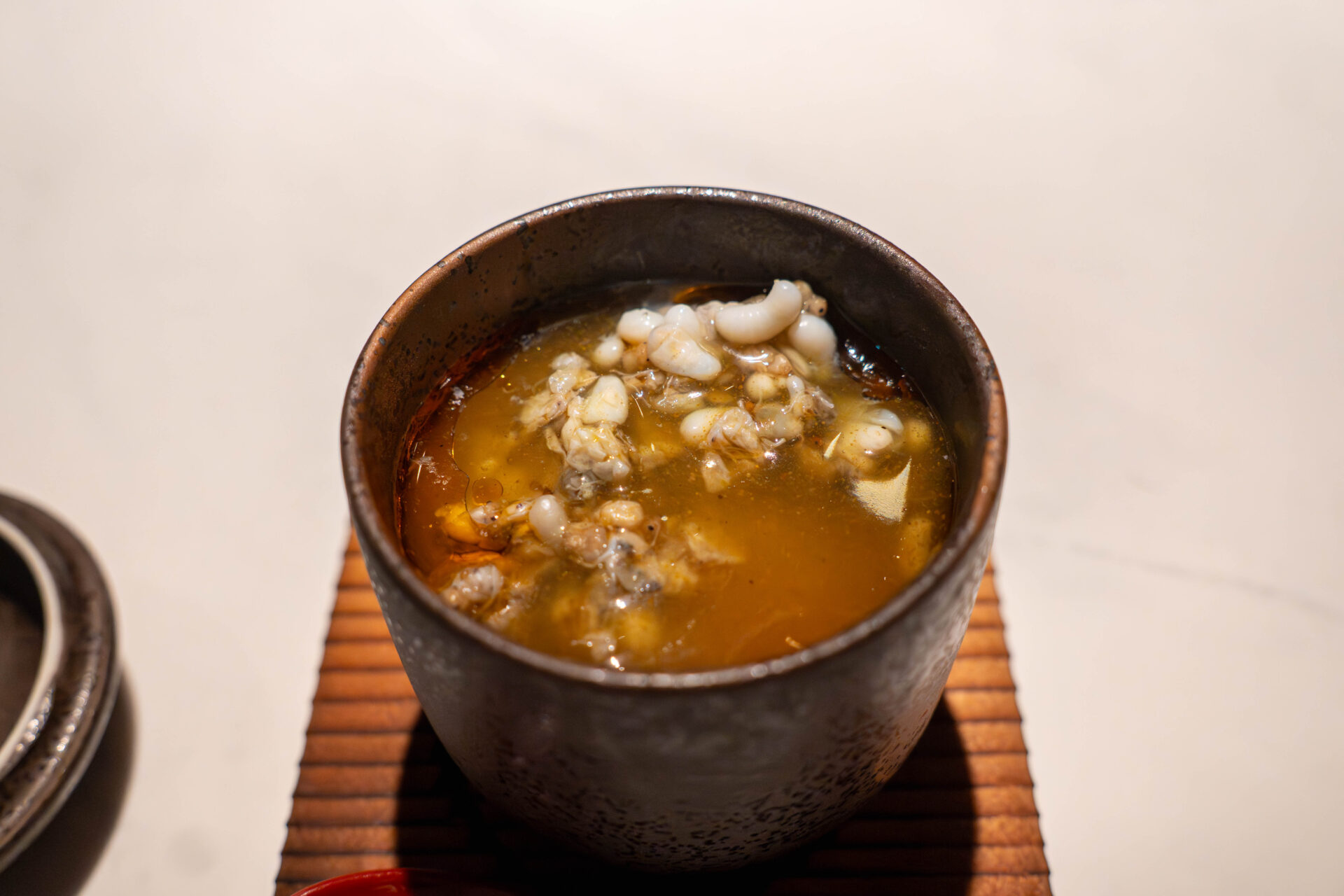
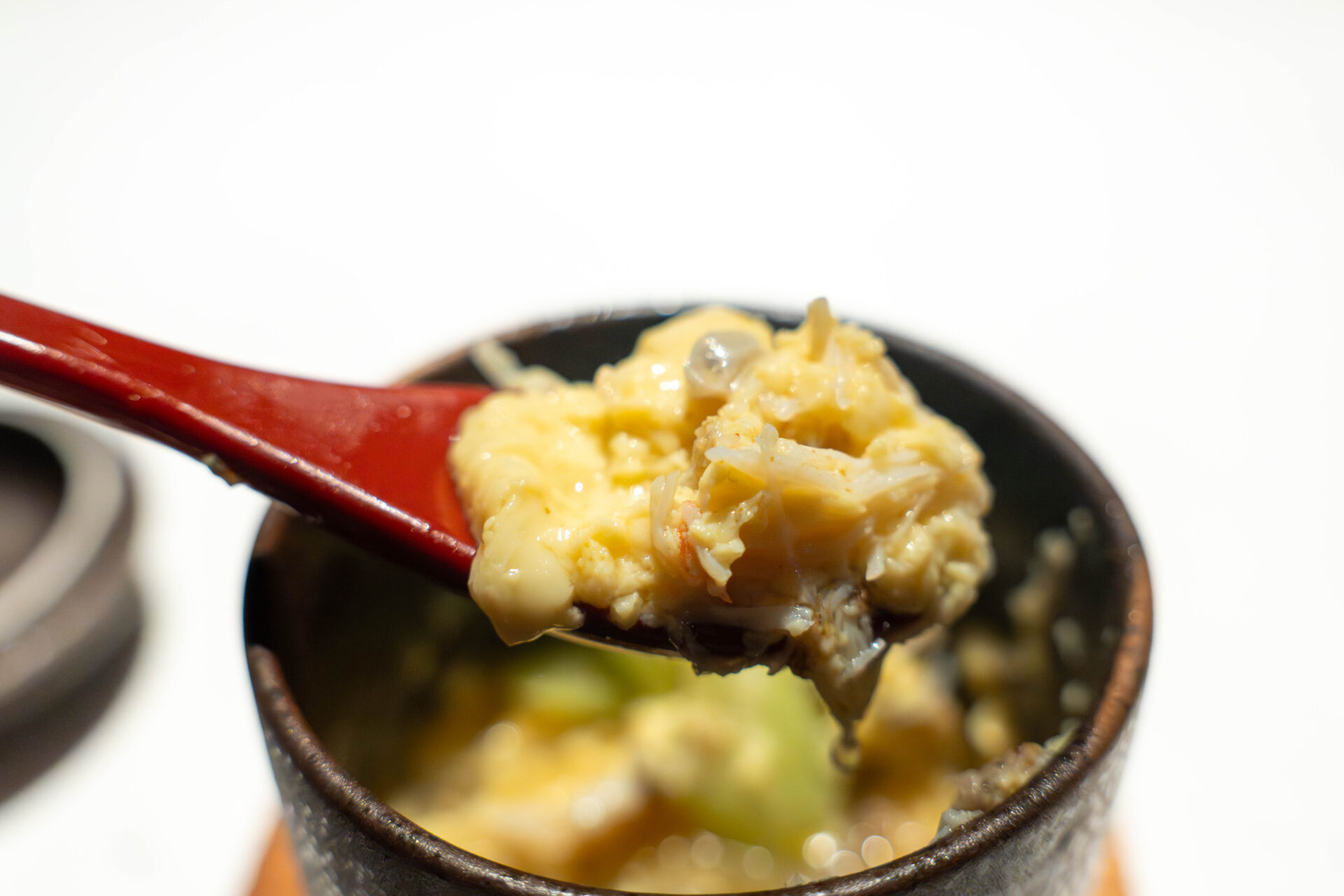
Between dishes, I ordered New Zealand’s organic ginger beer “Karma Drinks Gingerella.”
The retro-pop label caught the eye, while the taste delivered robust ginger spice and refreshing carbonation. With restrained sweetness, it paired well with the food and refreshed the palate.
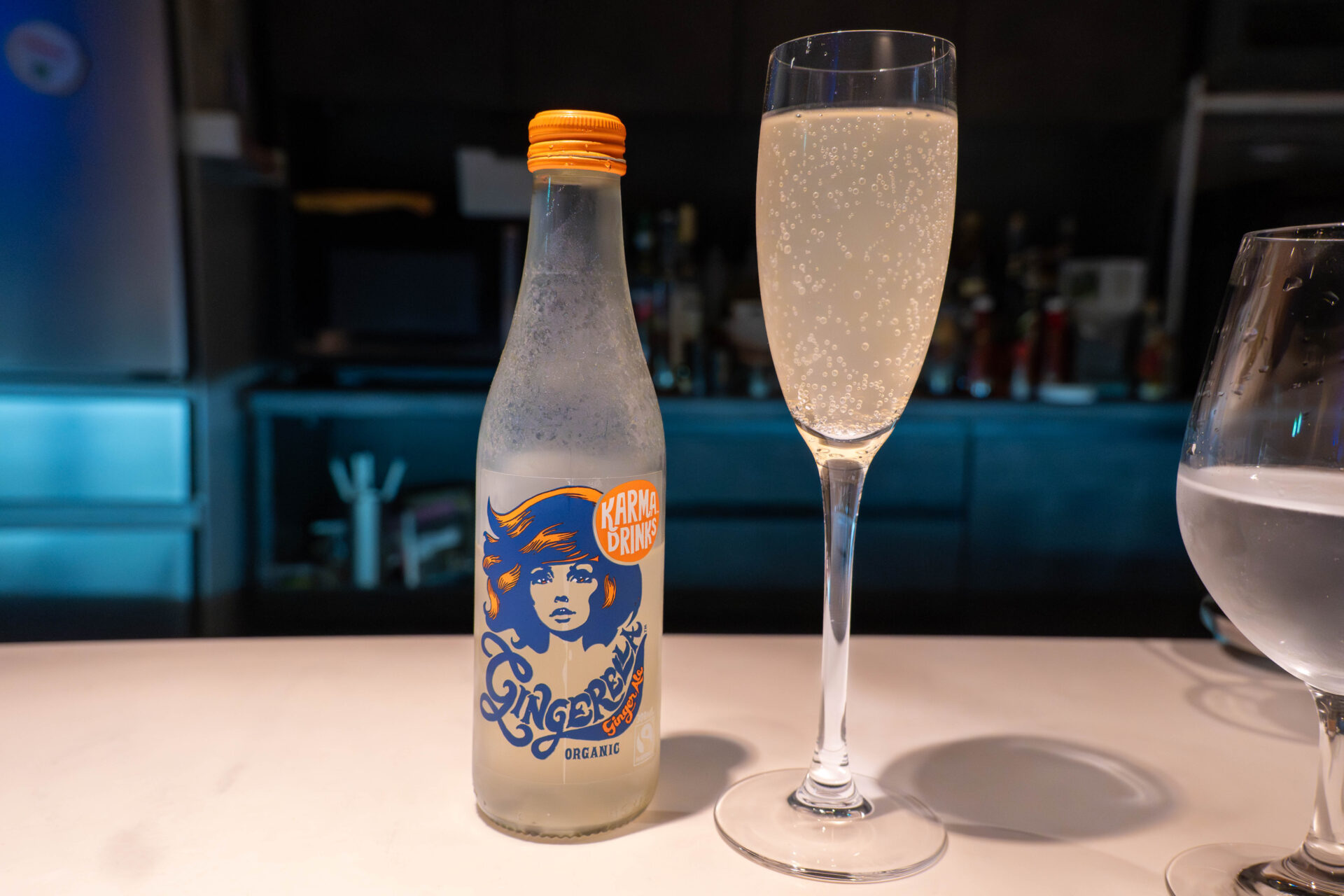
Do Miso
A Thai-style namero made with Pacific saury.
The finely chopped saury was mixed with aromatic herbs, enjoyed first as is, then with miso to experience a shift in flavor.
Crispy fried saury was placed on top for contrasting texture. The miso, based on Kumamoto’s “Himiko” and layered with multiple Thai fermented seasonings, added umami and complexity that lightened the fish’s rich fat.
As the name “Do Miso” suggests, it showcased the power of fermentation bridging Japanese and Thai cuisines.
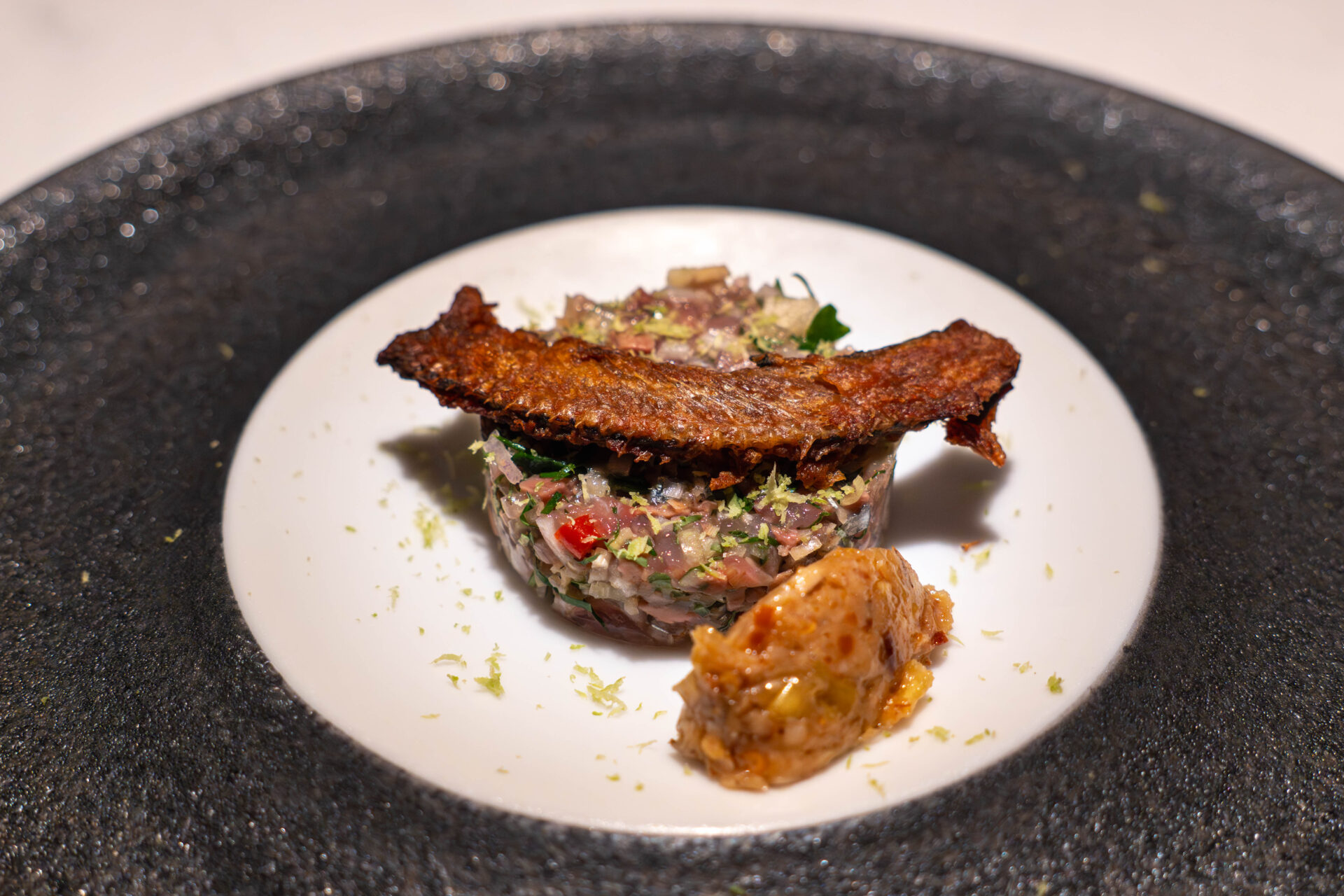
Global Warming
Next came Tom Saep, a soup from Northeast Thailand.
Its clear sourness was layered with fragrance and spice, featuring fresh beef tripe and omasum, delivering both strength and lightness.
Vegetables like celery were added, topped with cilantro for freshness and textural contrast. The more you drank, the more the heat and sourness spread warmly through the body.
The title “Global Warming” came from the idea that “cow burps cause climate change.” This humorous, critical reinterpretation of traditional cuisine was strikingly in character for this restaurant.
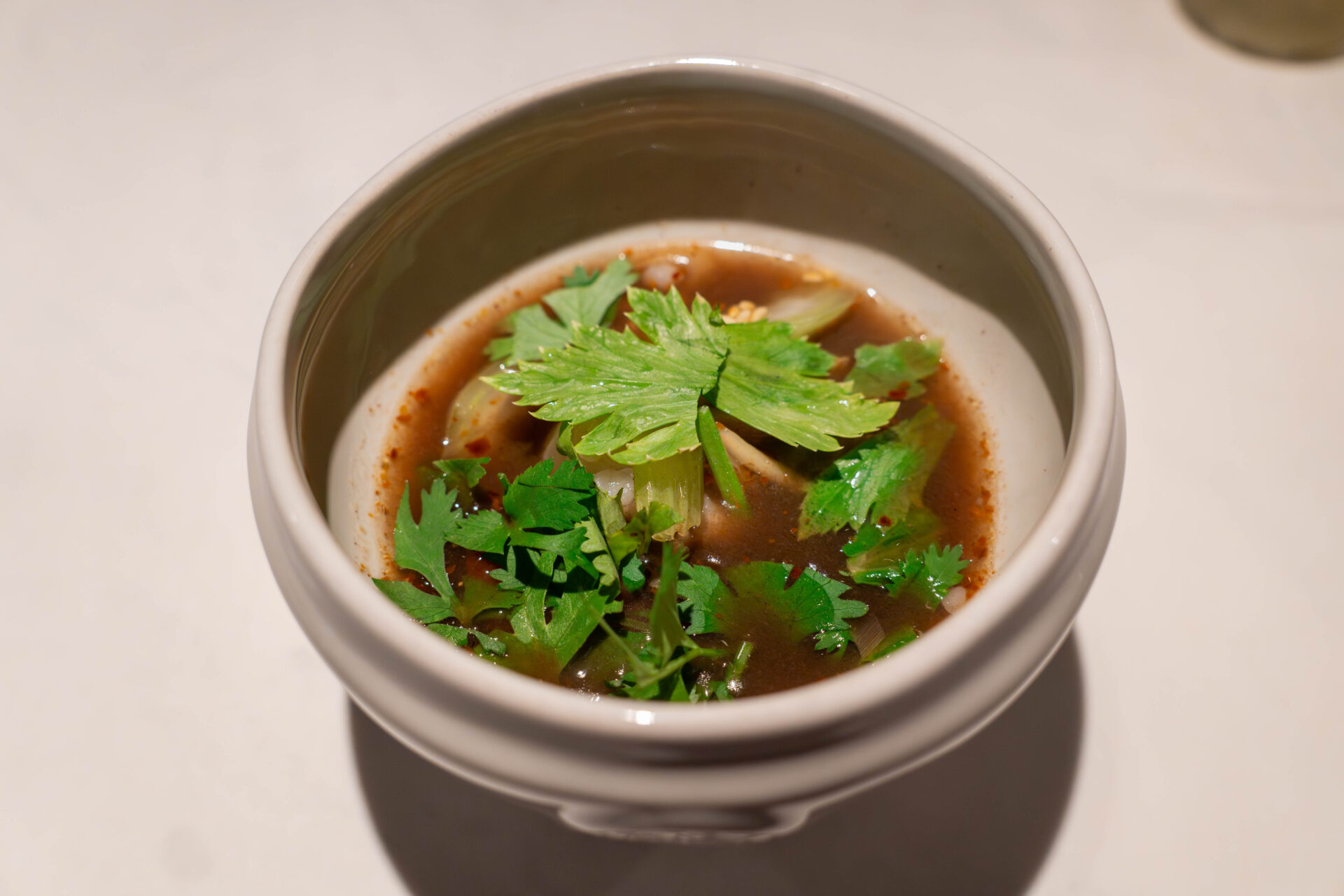
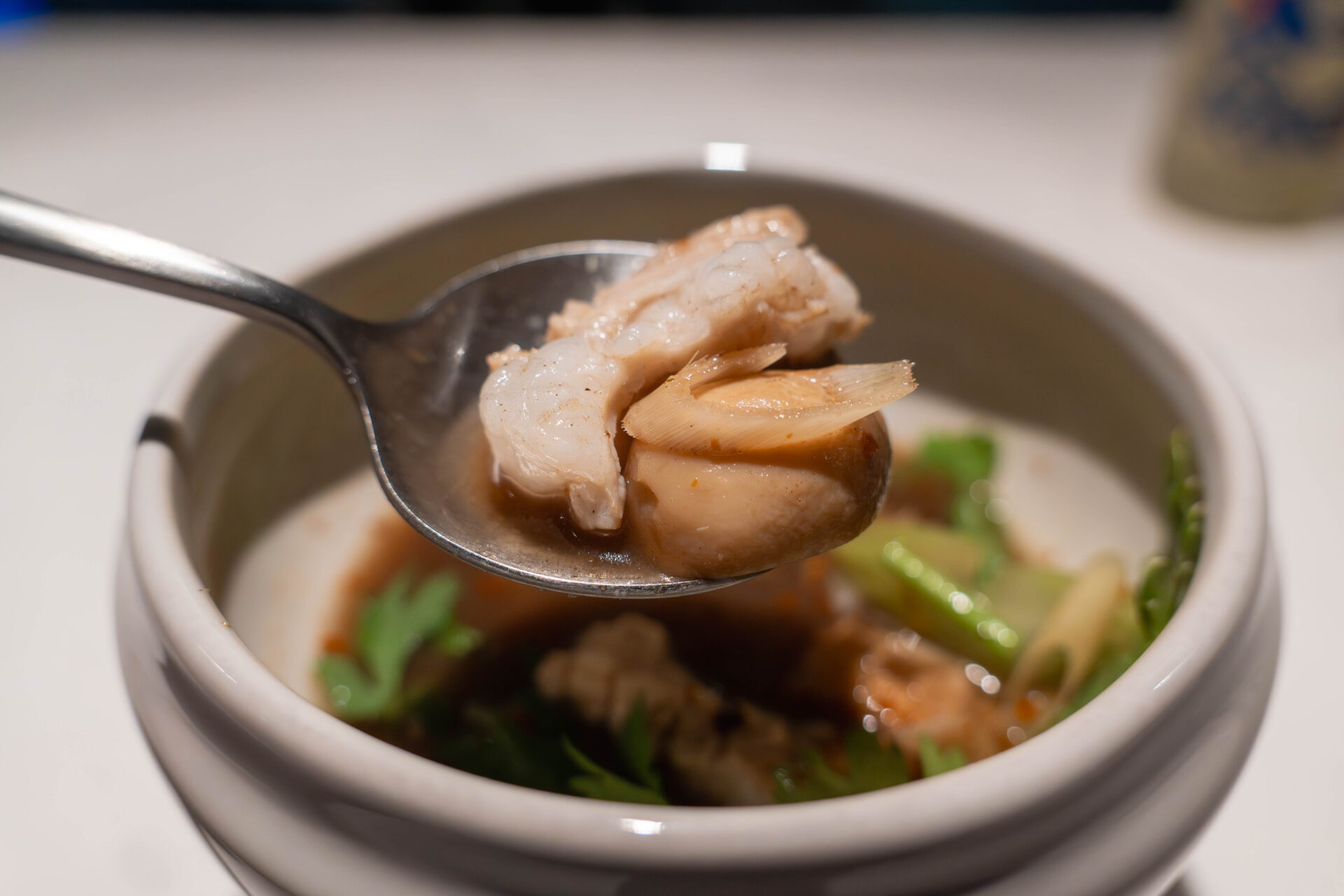
Invisible Shoreline
Next was Ark shell larb.
Ark shell was combined with red onion and cilantro, finished with toasted rice powder (khao khua) for aroma, creating a salad style. The fresh texture of the shellfish combined with herbs’ brightness and spices’ kick for a light yet layered taste.
Khao khua was also used effectively in other dishes, adding depth of flavor and texture.
This dish was originally intended to be paired with a high-proof whiskey—the bold liquor designed to resonate with the dish’s intensity.
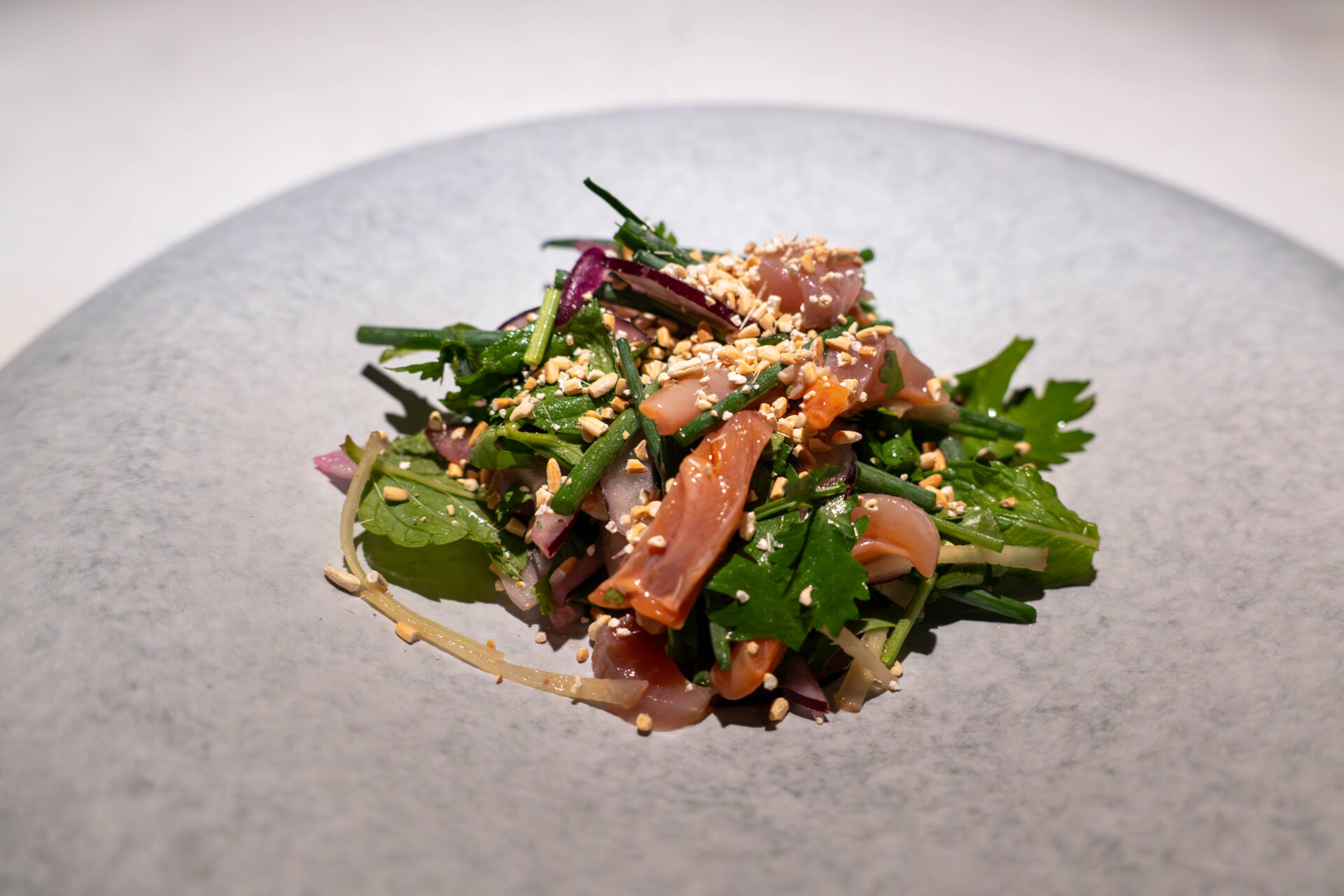
Cock a Doodle Do
The main dish fused Thai Isan cuisine with Mexican flavors.
The base was Thailand’s gai yang (grilled chicken), layered with the chef’s memory of guacamole from Mexico, fusing different food cultures.
Finished with a tequila flambé, perfumed with lime. Guests ate grilled chicken wings by hand, paired with guacamole, accompanied by a simple grilled green pepper. Strength and rusticity coexisted on the plate.
As the name “Cock a Doodle Do” suggests, the dish conveyed lively energy and festive joy.
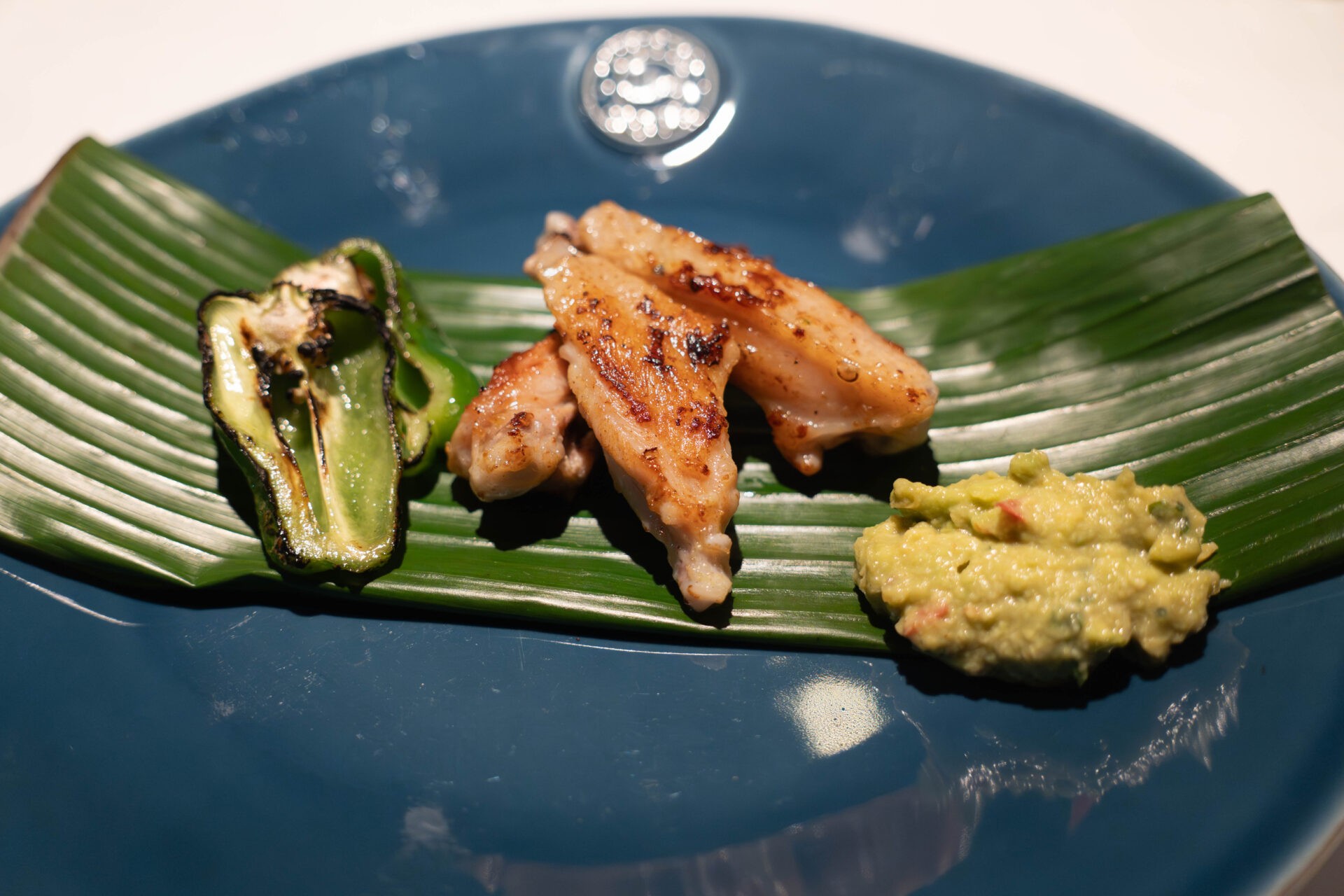
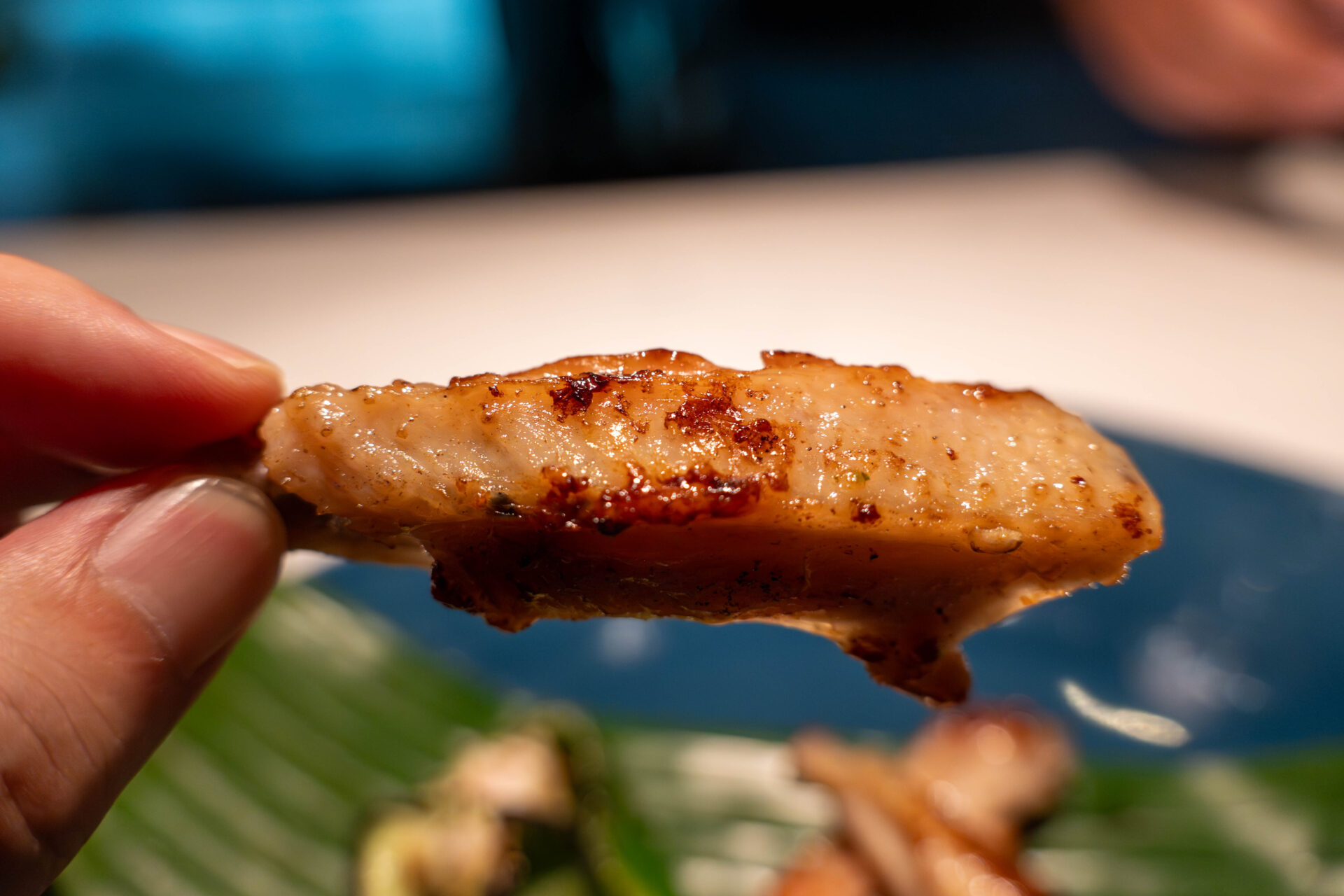
Final Grain
Here came a marinated tuna rice bowl.
On tamarind-scented jasmine rice was layered tuna marinated in fish sauce. A pickled sanshō berry added a refreshing spice, deepening the flavor.
Of the three tuna slices, I noticed the chef injecting something into the last one with a needle. When asked to guess after tasting, I couldn’t. The answer was detora orange—an intensely aromatic fruit, hidden like a secret accent.
This little trick, altering the taste of the fish, was another moment of discovery.
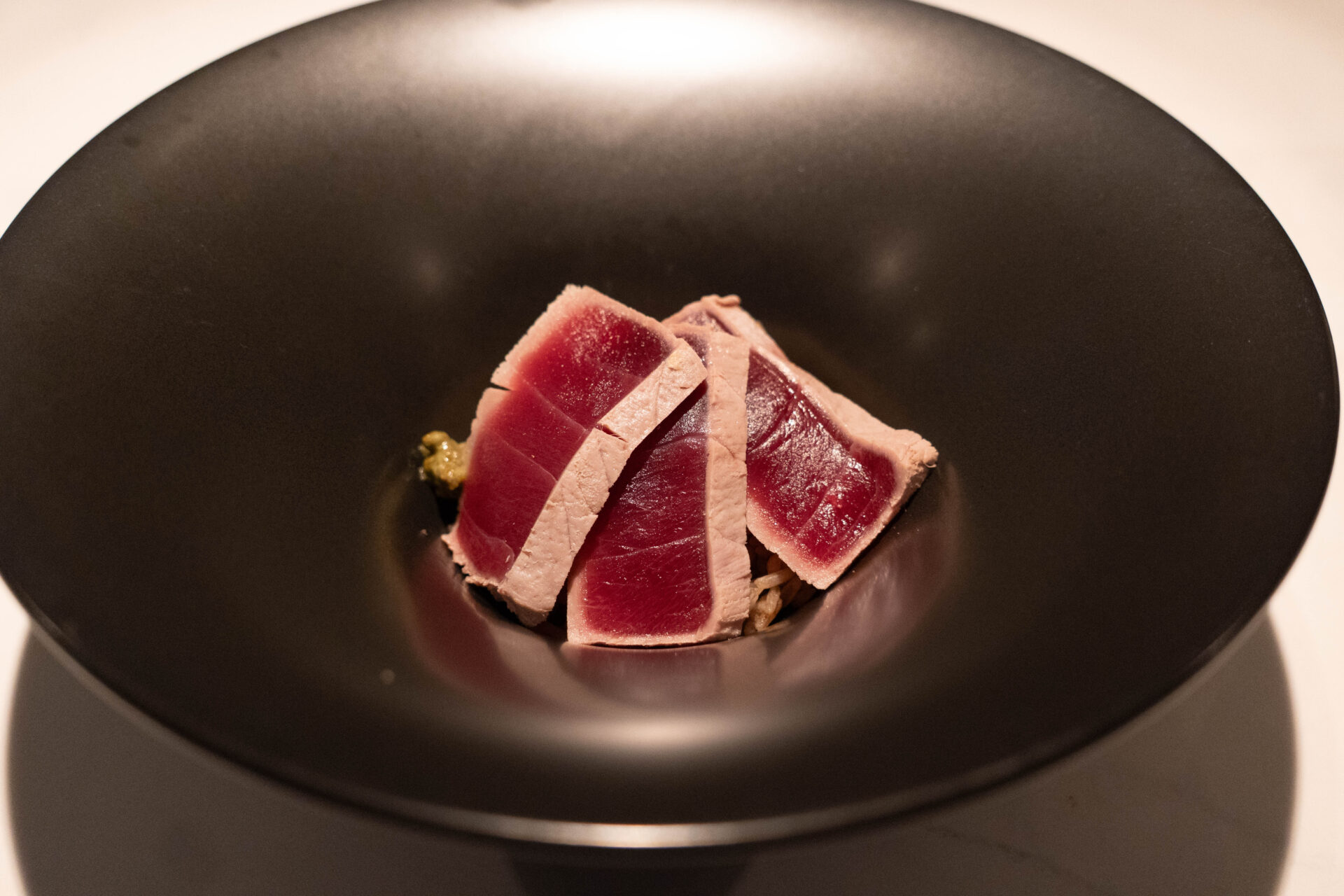
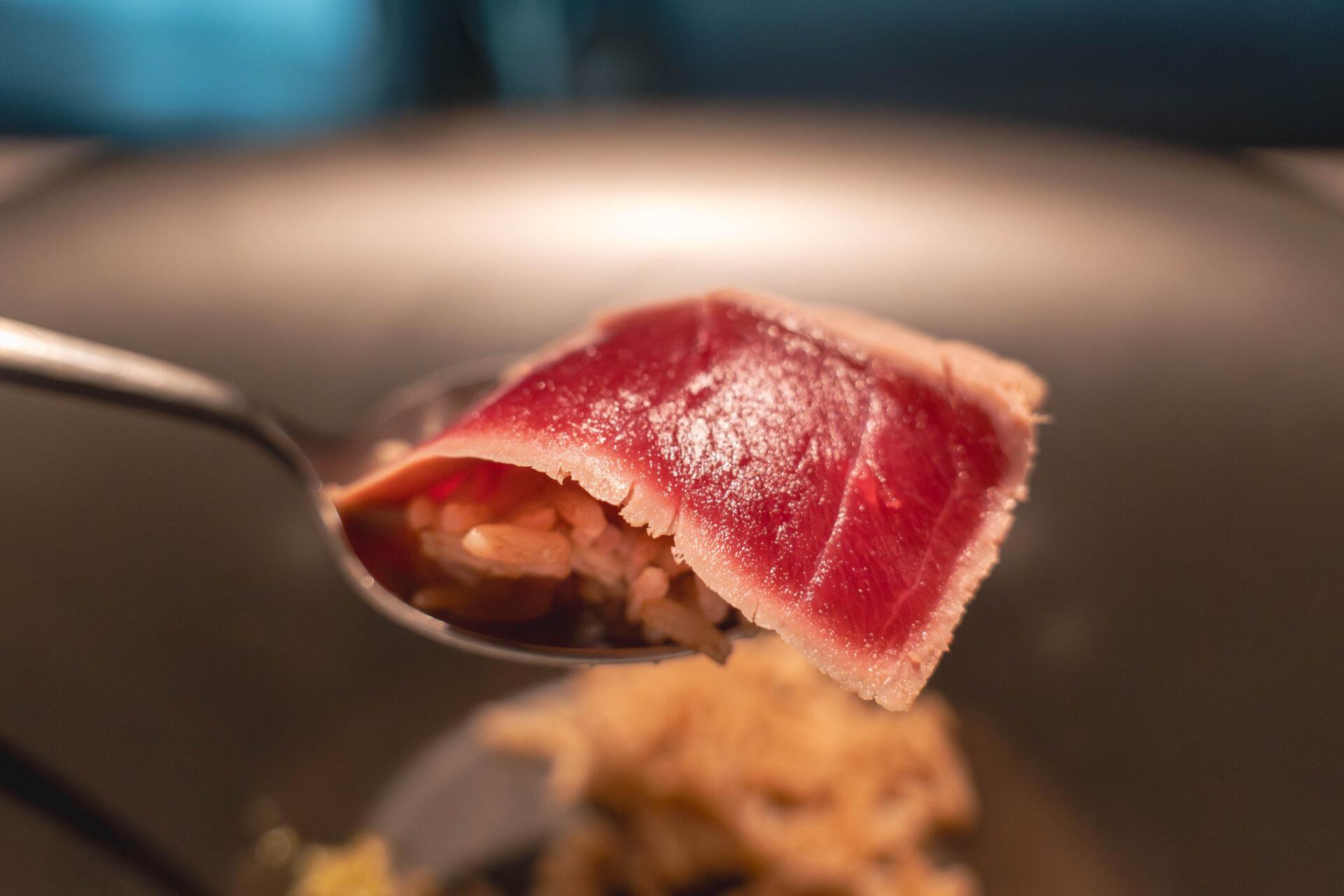
Rustle of Forest
Next was wild boar larb.
The arm meat of a female boar was minced and combined with toasted rice and herbs.
The roasted rice aroma, layered with herbs and tightened with lime acidity, created alternating waves of wildness and freshness. It evoked the sense of a forest rustling.
As the title “Rustle of Forest” suggested, the dish instantly brought the presence of the mountains to mind.
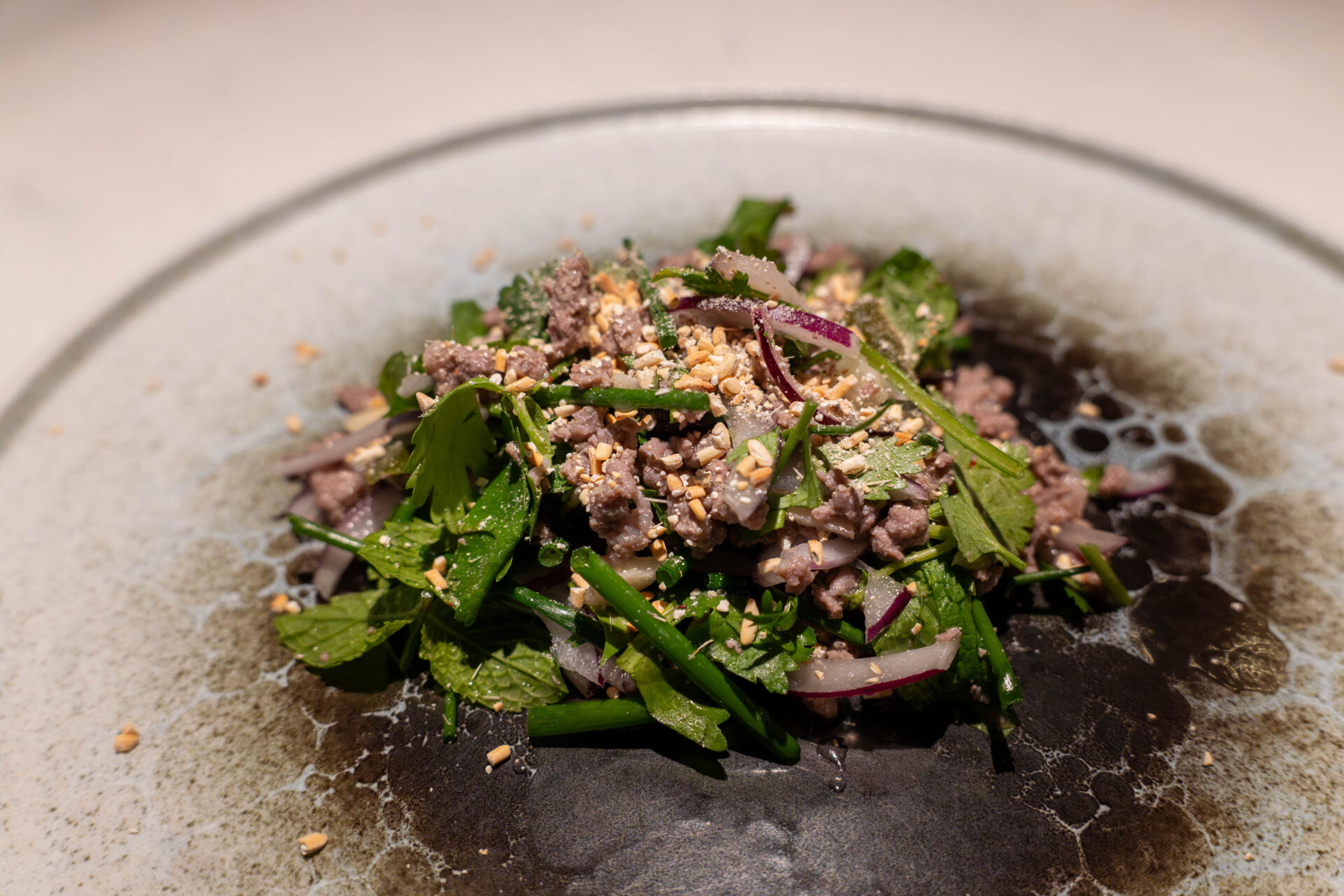
Desserts & Finale
Lazy Firefighter
The dessert was Shine Muscat grapes and melon.
Beneath them lay a jelly made from watermelon infused with chili and other spices.
The structure—juicy sweetness followed by a creeping heat—fit the title perfectly, like a “lazy firefighter.” Instead of putting out the fire, it mischievously added spice to a dessert course.
It was a bold, humorous finale that united sweetness and heat on a single plate.
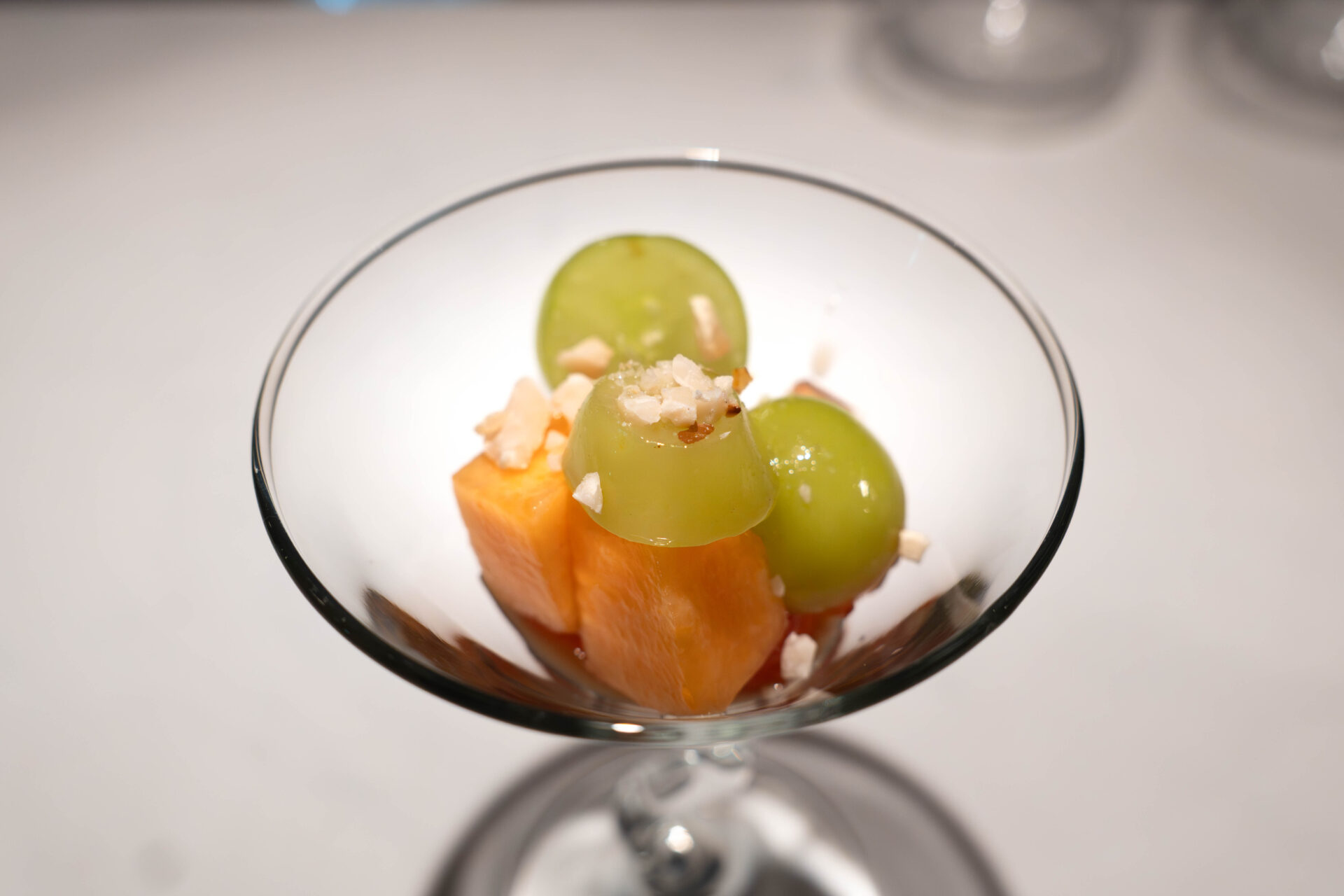
Azure Meadow
After the meal came a transparent blue herbal tea.
Its pale glow was like capturing the open sky of a meadow in a cup.
With a gentle aroma and soft mouthfeel, it quietly enveloped the lingering traces of spice and heat, bringing the course to a graceful close.
As its name “Azure Meadow” suggests, the tea evoked a blue meadow and served as a fitting finale to a dining experience like a long journey.
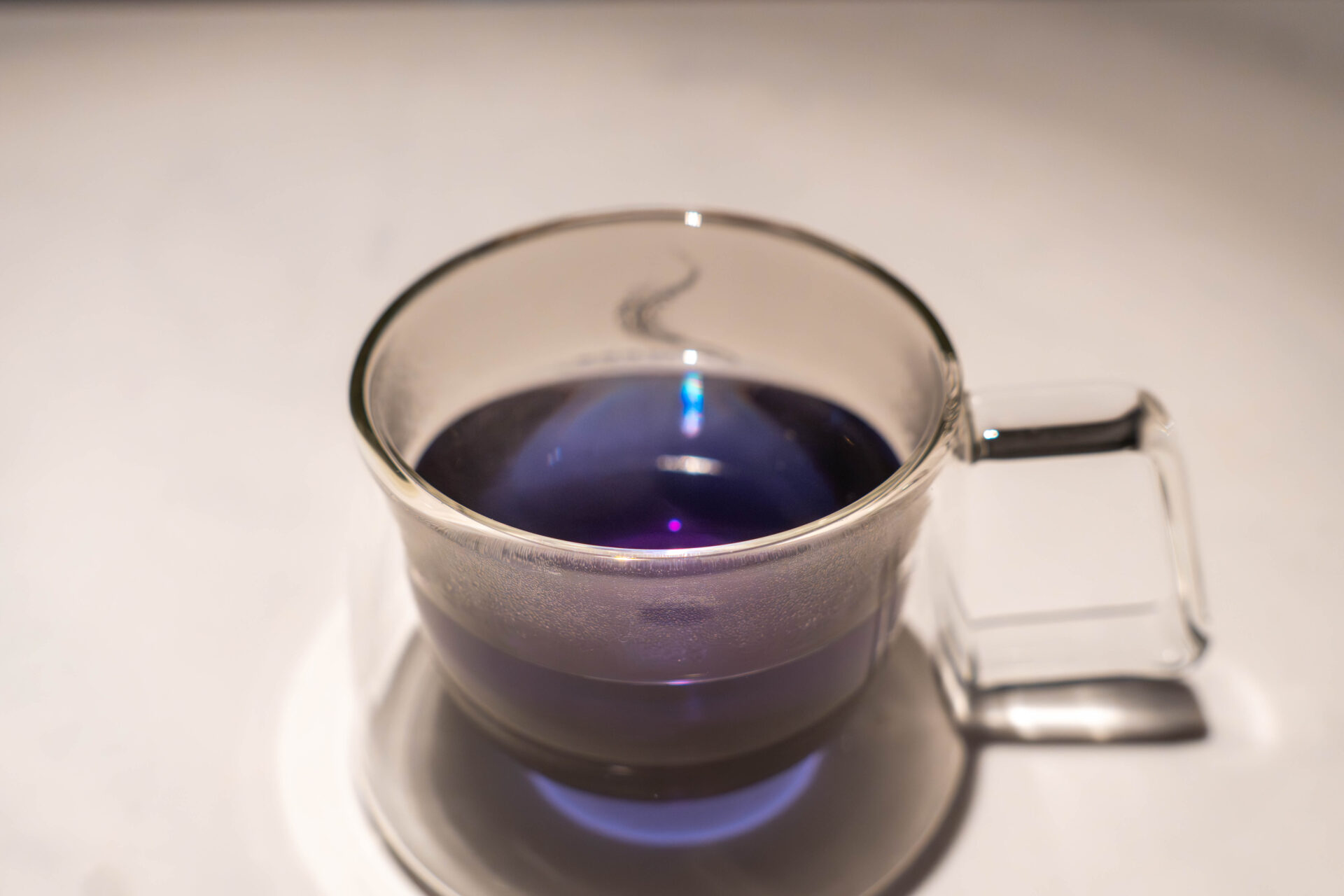
Impressions & Reflections
Dining at Kokura’s
The chef’s deep knowledge and dedication to ingredients shone through, even in seemingly whimsical elements, establishing a unique worldview. While this course leaned toward modern Thai, behind it lay accumulated multicultural experiences and flexible thinking, each dish revealing new perspectives on culinary potential.
Pairing food with wine and spirits, an area of the chef’s expertise, is meant to be the restaurant’s true essence. Yet even without pairings, each dish alone carried enough delicacy and depth to stir the heart.
Contrary to an impression of boldness and strength, the chef is more precise and delicate than appearances suggest. His ability to move seamlessly between playfulness and philosophy is what makes this place special.
And with KALA set to close in 2027, every moment feels precious—an “experience of now” not to be missed.
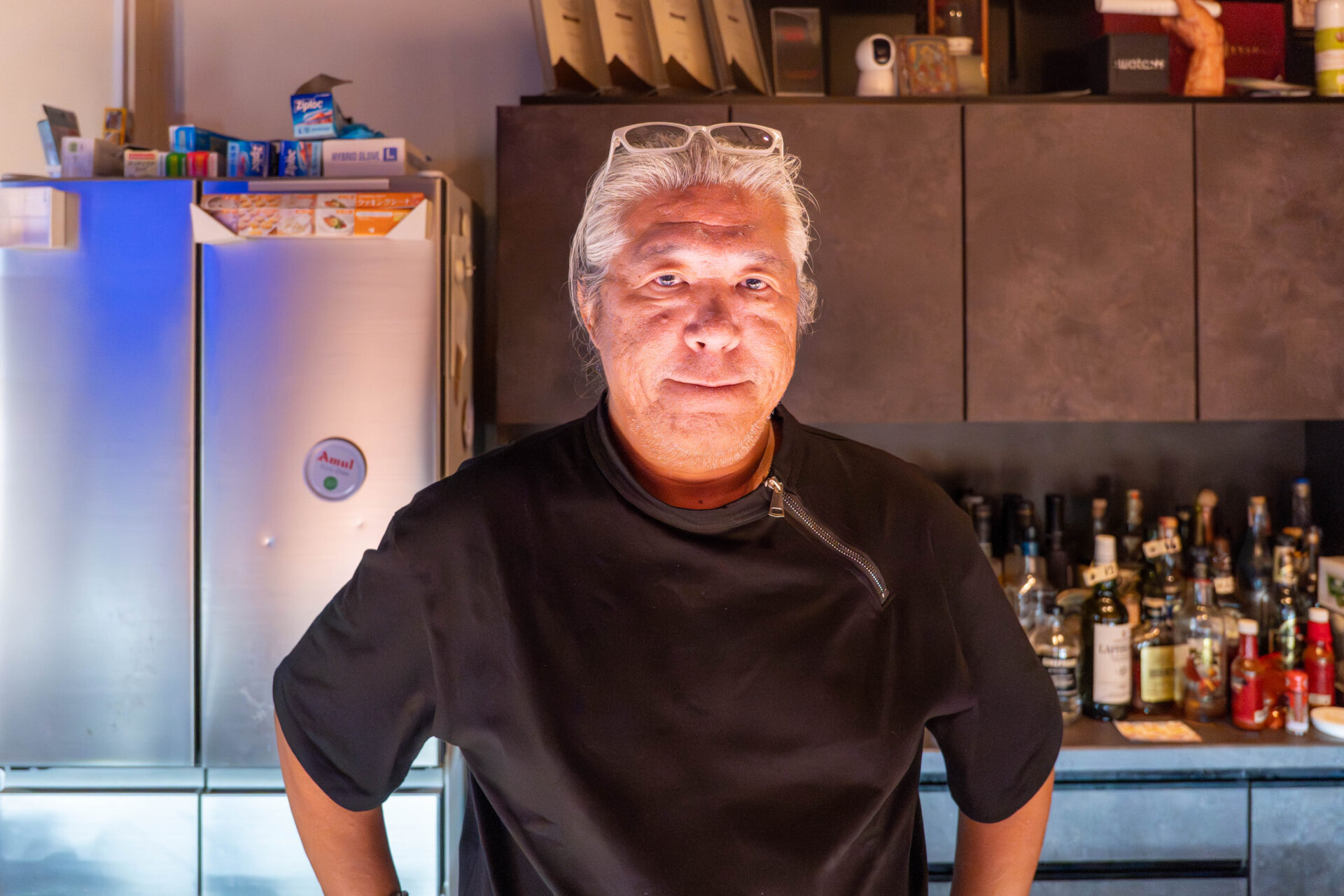
Reservations & Access
How to Reserve
- Reservations only. Walk-ins are generally not accepted.
- Reservations can be made via online platforms (AutoReserve or Tabelog).
- Phone reservations are also available: 090-7159-3045
- Guests who complete reservations receive the door passcode from the chef on the day. Upon arrival, they enter this code to unlock the door—adding a sense of exclusivity and anticipation from the very first step.
- Early reservations are recommended. Please note the cancellation policy (fees may apply for last-minute cancellations).
Access
- Address: 1F KN Building Bajaku, 3-3-30 Bajaku, Kokurakita Ward, Kitakyushu, Fukuoka
- Nearest station: About 4 minutes on foot (298m) from Kitakyushu Monorail “Tanga Station.”
- From JR Kokura Station: about 8 minutes by taxi. Mentioning “the yellow building along the monorail” makes it easy for drivers to locate.
- No parking available. Guests must use nearby coin parking.
Opening Hours
| Service | Hours | |
|---|---|---|
| Lunch | 12:00 – 16:00 (Last drink order 15:00) | |
| Dinner | 18:00 – 23:00 (Last drink order 22:00) | |
| Closed | Irregular holidays |
- TAGS

